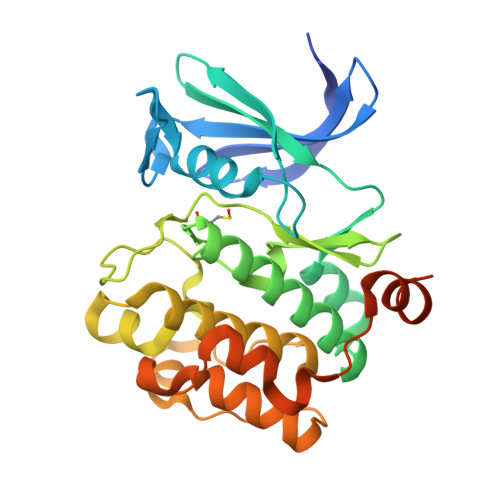Theoretical Analysis of Activity Cliffs among Benzofuranone-Class Pim1 Inhibitors Using the Fragment Molecular Orbital Method with Molecular Mechanics Poisson-Boltzmann Surface Area (FMO+MM-PBSA) Approach
Watanabe, C., Watanabe, H., Fukuzawa, K., Parker, L.J., Okiyama, Y., Yuki, H., Yokoyama, S., Nakano, H., Tanaka, S., Honma, T.(2017) J Chem Inf Model 57: 2996-3010
- PubMed: 29111719
- DOI: https://doi.org/10.1021/acs.jcim.7b00110
- Primary Citation of Related Structures:
5VUA, 5VUB, 5VUC - PubMed Abstract:
Significant activity changes due to small structural changes (i.e., activity cliffs) of serine/threonine kinase Pim1 inhibitors were studied theoretically using the fragment molecular orbital method with molecular mechanics Poisson-Boltzmann surface area (FMO+MM-PBSA) approach. This methodology enables quantum-chemical calculations for large biomolecules with solvation. In the course of drug discovery targeting Pim1, six benzofuranone-class inhibitors were found to differ only in the position of the indole-ring nitrogen atom. By comparing the various qualities of complex structures based on X-ray, classical molecular mechanics (MM)-optimized, and quantum/molecular mechanics (QM/MM)-optimized structures, we found that the QM/MM-optimized structures provided the best correlation (R 2 = 0.85) between pIC 50 and the calculated FMO+MM-PBSA binding energy. Combining the classical solvation energy with the QM binding energy was important to increase the correlation. In addition, decomposition of the interaction energy into various physicochemical components by pair interaction energy decomposition analysis suggested that CH-π and electrostatic interactions mainly caused the activity differences.
Organizational Affiliation:
RIKEN Center for Life Science Technologies , 1-7-22 Suehiro-cho, Tsurumi-ku, Yokohama 230-0045, Japan.

















